Porcelain Insulator News
by Elton Gish
Reprinted from "Crown Jewels of the Wire", September 2003, page 20
The Springfield National show was great for porcelain insulators. Two very
rare multipart porcelain insulator styles made their appearance for the first
time. One display brought attention from everyone at the show including the
glass collectors. And it captured seven awards! First, let's present the unusual
style, M-4710.
The first M-4710 was an unmarked specimen shown at the 1988
Allentown National. Jeff McCurty got the insulator about 20 years earlier
somewhere in upper New York. Chris Hedges bought the insulator for his
collection. It was obviously made by the Lima Insulator Co. (1904-1908). They
were apparently used on a steel-tower line that ran from Amsterdam to Balston
Spa, NY. This one has a metal thimble cemented in the pinhole that has 3/4"
machine threads. It is a huge 4-part insulator (17 - 11.5 - 16.5 - 7 x 16) with a
recessed inner skirt.
In late 1901, Ken Willick purchased a M-4710 with the
incuse marking, LIMA. N.Y. Bob Pierce found it at a yard sale in upper New York.
The pinhole was not threaded but did have grooves for cementing a metal
thimble. It appeared to have been unused.
This. confirms M-4710 was made by Lima
no later than 1908 before the factory was completely destroyed by fire. A couple
of people have a good idea which line they were used on but no trace of them
have been discovered in the field. It is amazing that two huge insulators have
survived intact for almost 100 years.
Ron Yuhas found another M-4710 in
Montana! It was being used as a garden ornament with several inches of the
bottom skirt buried in the soil. When I saw this insulator at the Springfield
National, it was obviously not a Lima product, but instead an early production
of the R. Thomas & Sons Co. From the glaze color, I would guess it was made
around 1908-1912. This Thomas M-4710 still had the heavy steel pin cemented in
the pinhole. The attachment device on the pin indicates the insulator may have
been used on a steel tower or in a substation or powerhouse. Carver Mead and
Barbara Smith are now the proud owners of this very unusual insulator.
The
Thomas M-4710 is nearly identical in size to the Lima version with the diameters
of each of the four skirts within 0.3" or less. Note the profile of the
large bell-shaped bottom skirt is different. The skirt on the Thomas has a
gentle curvature lily-shell profile whereas the Lima skirt has a definite break
in the profile flaring straight out to the bottom edge.
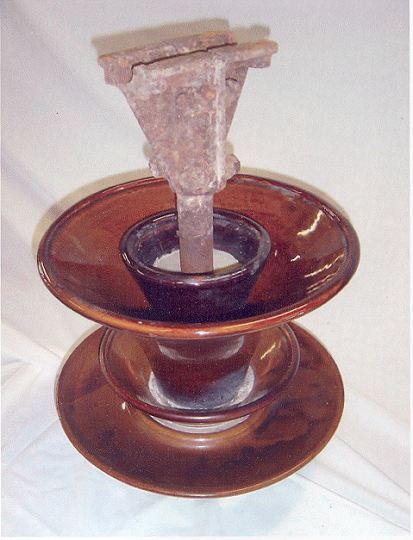
M-4710 N-N Thomas showing steel pin cemented in the pinhole.
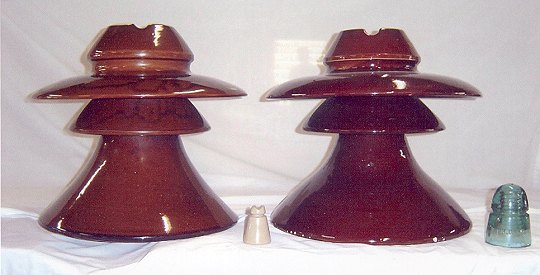
M-4710 N-N Thomas (left) and M-4710 Lima (right).
Carver Mead and Barbara Smith set up the most incredible display I have ever
seen. In addition, they transported the huge insulators and museum quality
display all the way from southern California! More of their incredible story and
photographs can be viewed on my web site, www.rinfinity. com. The display was
also set up for the enjoyment of visitors to the NIA Western Regional Show in
San Jose, CA in August of this year.
Previously, only one specimen of a Thomas
M-4800 was known. It was shown at the 1988 Allentown National and purchased by
Mike Guthrie. Bill Rohde currently owns that insulator. It is well documented in
the trade journals that M-4800 was used in southern California on the
60,000-volt power line that ran 117 miles from the Kern River No.1 Powerhouse to
Los Angeles. The line was put into service in 1907. The trade journals talk
about a gray insulator made by Locke. Mike Spadafora searched the line
extensively and only found a few fragment of the gray Victor as well as pieces
of M-4800 made by Thomas and New Lexington.
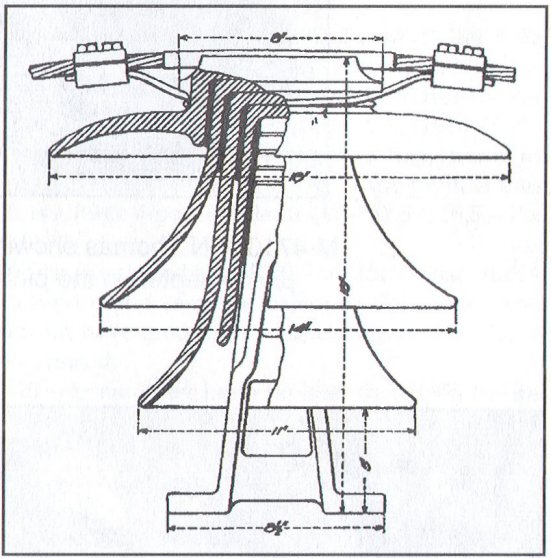
Carver Mead and Barbara Smith became very interested in the Kern-1 line last
year. Carver's father worked on the line so it holds special meaning for him.
They took on the challenge of finding a whole specimen and researched the line
and route in great detail. They found one section of the line where the concrete
footing of the towers had been bulldozed out of the ground. The concrete had
pieces of M-4800 sticking out of them. The line had been upgraded in 1916 to
suspension insulators. The M-4800's were removed and thrown in holes drilled in
the ground for concrete footings to better support the existing towers.
They
guessed that it would be useless to search sections of line that used concrete
footings and the best location to search would be rugged, inaccessible sections
where concrete footings were not used. There was a five-mile section through
Piru canyon that appeared the best place to search. The almost impenetrable sea
of 8-foot tall brush proved extremely difficult to search with its thorns
ripping up their clothes. Usually the brush is kept under control by occasional
fires every 20-40 years; however, one section had not been burned by fire in
about 85 years. All of the towers had been removed in 1973 so it was difficult
to find a tower site in the heavy brush. Sure enough, the tower sites showed no sign of concrete footings.
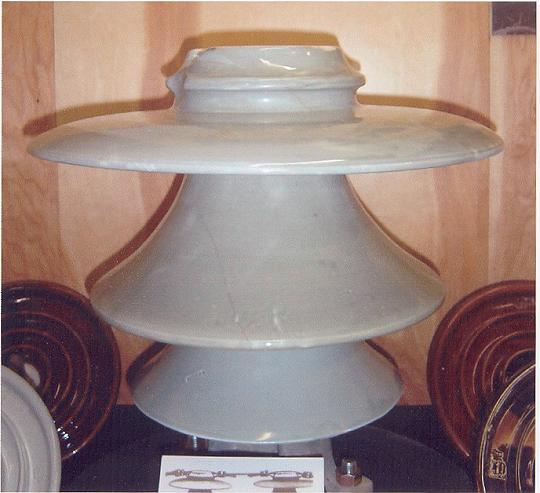
Gray M-4800 with Victor marking.
Carver and Barbara found three damaged insulators. One was a gray Victor, one
an unmarked Thomas, and one an unmarked New Lexington. They were able to
piece together broken parts for the Victor and Thomas. The New Lexington
specimen required the assembly of broken parts from more than one insulator.
Some pieces had to be expertly cut to fit. The final result is very nice
complete with a section of conductor and the crown clamp assembly. The glazes on
each of the three insulators are typical of production in 1907-1908. Sometimes
kitsulator specimens are the only way we can see what the original insulator
looked like.
The three specimens are indeed spectacular!!
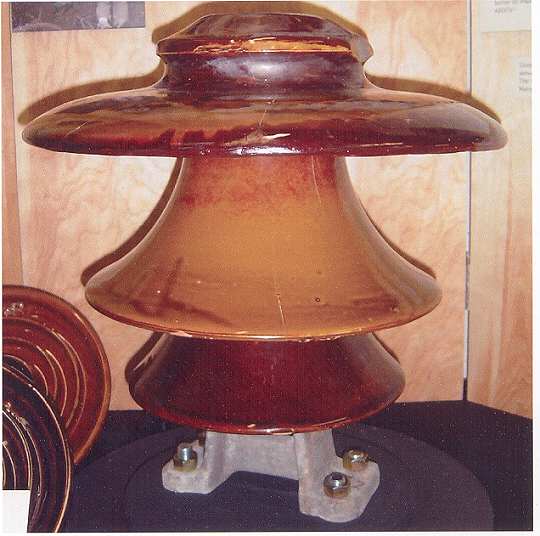
Thomas M-4800
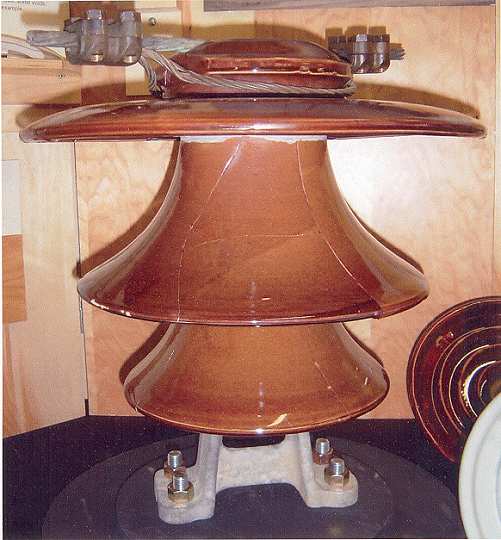
New Lexington M-4800
| 